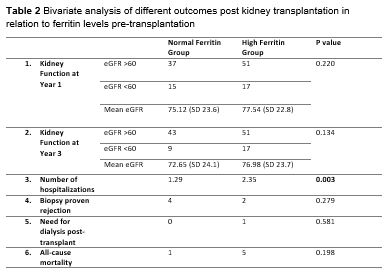
Contributions
Abstract: EP849
Type: E-Poster Presentation
Session title: Iron metabolism, deficiency and overload
Background
One of the most important aspects in the care of CKD patients is addressing anemia. Treatment includes iron replacement and blood transfusion which can lead to hemosiderosis. Abnormal iron balance, whether iron deficiency or iron overload is associated with increased mortality in CKD patients. Prospective cohorts showed increased mortality in kidney transplant patients with high post-transplant ferritin levels however no literature regarding the relationship of pre-transplant ferritin status has been published yet.
Aims
To determine the relationship of pre-transplant ferritin and transferrin saturation levels to outcomes post-transplant including overall survival, graft survival and renal function and incidence of hospitalizations.
Methods
The study design is a retrospective cohort. The subjects were 124 post-transplant patients divided into two groups (high ferritin vs. normal ferritin). Demographic data such as age, gender, transferrin saturation, etiology of CKD, duration and mode of renal replacement therapy, type of graft donor and history of blood transfusions were recorded. The outcomes investigated were: (1) Creatinine clearance at one- and three-years post-transplant (2) number of hospitalizations, (3) biopsy-proven graft rejection, (4) need for dialysis and (5) all-cause mortality. The statistical analyses used were univariate and bivariate analyses (chi-square) and multivariate analysis using multiple logistic regression (factor analysis and MANOVA).
Results
Demographic and clinical background for both arms were not significantly different (p >0.05). Patients with high ferritin were more likely to also have high transferrin saturation. (p 0.003). There was significant association between ferritin status pre-transplant and number of hospitalizations post-transplant (p 0.003) which can represent higher morbidity in this subset. No significant difference in terms of one- and three-year renal function, incidence of biopsy-proven graft rejection, need for dialysis post-transplantation or all-cause mortality was elicited between the two groups.
Conclusion
There is a strong association between pre-transplant hyperferritinemia and number of hospitalizations after renal transplantations, and therefore a good predictor of morbidity especially infection-related complications.There is no difference in mortality and graft function between renal transplant patients with high and normal pre-transplant ferritin levels. Pre-transplant ferritin and transferrin saturation levels in this group may not be a good predictor for mortality.
Keyword(s): Ferritin, Iron overload, Mortality, Transplant
Abstract: EP849
Type: E-Poster Presentation
Session title: Iron metabolism, deficiency and overload
Background
One of the most important aspects in the care of CKD patients is addressing anemia. Treatment includes iron replacement and blood transfusion which can lead to hemosiderosis. Abnormal iron balance, whether iron deficiency or iron overload is associated with increased mortality in CKD patients. Prospective cohorts showed increased mortality in kidney transplant patients with high post-transplant ferritin levels however no literature regarding the relationship of pre-transplant ferritin status has been published yet.
Aims
To determine the relationship of pre-transplant ferritin and transferrin saturation levels to outcomes post-transplant including overall survival, graft survival and renal function and incidence of hospitalizations.
Methods
The study design is a retrospective cohort. The subjects were 124 post-transplant patients divided into two groups (high ferritin vs. normal ferritin). Demographic data such as age, gender, transferrin saturation, etiology of CKD, duration and mode of renal replacement therapy, type of graft donor and history of blood transfusions were recorded. The outcomes investigated were: (1) Creatinine clearance at one- and three-years post-transplant (2) number of hospitalizations, (3) biopsy-proven graft rejection, (4) need for dialysis and (5) all-cause mortality. The statistical analyses used were univariate and bivariate analyses (chi-square) and multivariate analysis using multiple logistic regression (factor analysis and MANOVA).
Results
Demographic and clinical background for both arms were not significantly different (p >0.05). Patients with high ferritin were more likely to also have high transferrin saturation. (p 0.003). There was significant association between ferritin status pre-transplant and number of hospitalizations post-transplant (p 0.003) which can represent higher morbidity in this subset. No significant difference in terms of one- and three-year renal function, incidence of biopsy-proven graft rejection, need for dialysis post-transplantation or all-cause mortality was elicited between the two groups.
Conclusion
There is a strong association between pre-transplant hyperferritinemia and number of hospitalizations after renal transplantations, and therefore a good predictor of morbidity especially infection-related complications.There is no difference in mortality and graft function between renal transplant patients with high and normal pre-transplant ferritin levels. Pre-transplant ferritin and transferrin saturation levels in this group may not be a good predictor for mortality.
Keyword(s): Ferritin, Iron overload, Mortality, Transplant



